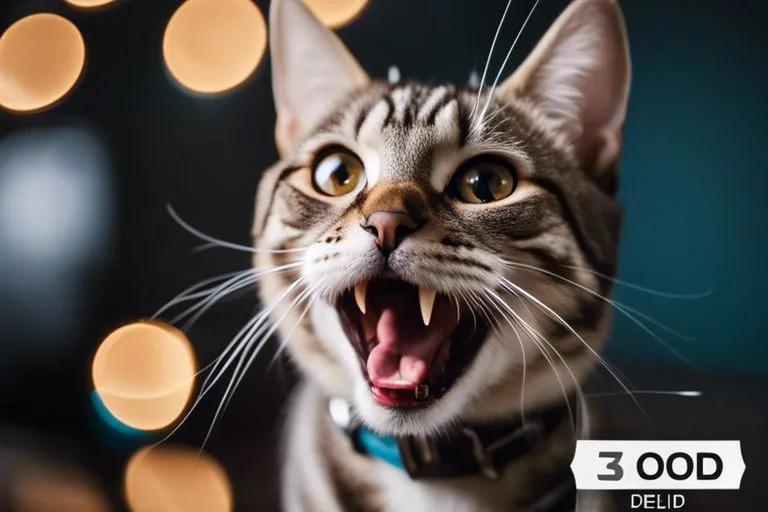You may not be aware of it, but periodontal disease is a common issue in American Shorthair cats that can lead to serious health problems if left untreated. You should be vigilant for signs such as bad breath, swollen gums, difficulty eating, and drooling, which can indicate the presence of periodontal disease in your cat. Additionally, you may also notice loose or missing teeth, redness or bleeding in the gums, and a buildup of tartar on the teeth. It’s important to recognize these symptoms early on, as untreated periodontal disease can result in infections, tooth loss, and even damage to your cat’s organs. In this blog post, we will discuss in detail the signs and symptoms of periodontal disease in American Shorthair cats, as well as provide tips for prevention and treatment.
Key Takeaways:
- Bad Breath: One of the most common signs of periodontal disease in American Shorthair cats is persistent bad breath, which is often caused by bacteria in the mouth.
- Gum Inflammation: Red, swollen, or bleeding gums are a clear indication of periodontal disease and should be monitored and addressed by a veterinarian.
- Tooth Loss: As periodontal disease progresses, cats may experience loose or missing teeth, leading to difficulty eating and potential health issues.
Identifying Periodontal Disease
Now, recognizing the signs and symptoms of periodontal disease in your American Shorthair cat is crucial to maintaining their oral health. Periodontal disease is a common condition that affects many cats, and it can lead to serious health problems if left untreated. To learn more about dental disease in cats, you can visit Dental Disease in Cats: Causes, Symptoms, & Treatment.
Early Signs of Dental Issues
If you notice that your cat has bad breath, discolored teeth, or difficulty eating, these may be early signs of dental issues. Other signs may include drooling, pawing at the mouth, or avoiding hard kibble. It’s essential to pay attention to these early signs and take action promptly for the best chance of successful treatment. Regular dental check-ups and at-home dental care can help prevent these issues from developing into more severe problems.
Progression of Periodontal Disease Symptoms
As periodontal disease progresses, you may notice more severe symptoms, such as swollen or bleeding gums, loose teeth, and abscesses in the mouth. Your cat may also become more irritable or lethargic due to the pain and discomfort caused by the disease. It’s important to address these symptoms as soon as possible to prevent further damage to your cat’s oral health. Left untreated, periodontal disease can lead to tooth loss, organ damage, and even life-threatening infections.
Risk Factors and Prevention
Assuming you have an American Shorthair cat, there are specific risk factors and preventative measures you need to be aware of to keep your feline friend’s oral health in check. Without proper care, your cat may be at higher risk for mouth periodontal disease, leading to potential discomfort and health issues. The following are important factors to consider in preventing mouth periodontal disease in American Shorthair cats:
- Diet: A high-carbohydrate diet can contribute to plaque and tartar build-up, increasing the risk of periodontal disease.
- Genetics: Some felines are genetically predisposed to dental issues, making regular dental care even more crucial.
- Age: As your cat ages, the risk of dental problems also increases, which is why regular dental care is essential.
Assume that understanding these risk factors is crucial to preventing mouth periodontal disease in your American Shorthair cat. You can learn more about Cat Dental – How Dental Care Affects a Cat’s Overall Health for additional information on preventative measures and dental care practices.
Genetic and Lifestyle Risk Factors
Genetic predisposition and the lifestyle of your American Shorthair can play a significant role in the development of mouth periodontal disease. Factors such as diet, genetics, and age can contribute to an increased risk of dental issues. You need to be aware that genetics can influence your cat’s susceptibility to periodontal disease. This emphasizes the importance of regular dental care to prevent potential issues from arising.
Preventative Measures and Dental Care Practices
When it comes to preventing mouth periodontal disease in your American Shorthair cat, there are several crucial preventative measures you can take. Regular dental check-ups, a balanced diet, and proper oral hygiene are key factors in maintaining your cat’s oral health. Establishing a dental care routine and incorporating dental-friendly treats and toys can also play a significant role in preventing dental problems. Consulting with your veterinarian to implement an effective dental care plan is essential for maintaining your cat’s overall well-being.
Diagnosis and Treatment Options
Keep in mind that diagnosing mouth periodontal disease in American Shorthair cats may require professional expertise. If you notice any of the signs mentioned in the previous section, it’s important to consult a veterinarian for a proper diagnosis. To learn more about the warning signs of feline periodontal disease, you can visit What are some warning signs of feline periodontal disease?
Professional Veterinary Diagnosis Procedures
When you take your American Shorthair cat to the vet, they will conduct a thorough dental examination, which may include dental X-rays to assess the extent of the disease beneath the gum line. They may also perform a periodontal probing to measure any pockets around the teeth where bacteria may be causing damage. Depending on the severity of the disease, your vet may recommend a full dental cleaning under general anesthesia to remove bacteria and tartar buildup. It’s important to follow your vet’s recommendations for treatment to ensure the best possible outcome for your cat.
Available Treatment Methods and Recovery Expectations
If your American Shorthair cat is diagnosed with mouth periodontal disease, treatment will vary depending on the severity of the condition. Your vet may recommend at-home dental care, such as regular tooth brushing and special dental diets, to help prevent the progression of the disease. In more severe cases, your cat may need dental surgery to remove diseased tissue or even tooth extraction. Recovery expectations will also depend on the specific treatment plan recommended by your veterinarian. It’s important to follow their instructions closely to ensure the best possible outcome for your furry friend.
Ongoing Management and Prognosis
Your American Shorthair cat’s ongoing management and prognosis for periodontal disease will depend on the severity of the condition and the response to treatment. It’s important to work closely with your veterinarian to create a long-term plan for managing your cat’s oral health.
Long-term Dental Health Management
Long-term management of your American Shorthair cat’s dental health will likely involve a combination of professional dental cleanings under anesthesia and regular at-home dental care. Your veterinarian may recommend special dental diets, dental chews, or toothbrushing techniques to help prevent the progression of periodontal disease. It’s essential to prioritize your cat’s dental health to prevent further issues from developing.
Prognosis for Cats with Periodontal Disease
The prognosis for cats with periodontal disease can vary depending on the severity of the condition and the response to treatment. Early detection and intervention are crucial for a more favorable prognosis. If left untreated, periodontal disease can lead to tooth loss, oral pain, and systemic health issues. However, with appropriate management and regular monitoring, many cats can maintain good oral health and overall well-being.
Conclusion
Hence, it is important for you to be aware of the signs and symptoms of periodontal disease in your American Shorthair cat. By recognizing the early signs such as bad breath, swollen gums, and difficulty eating, you can take proactive steps to prevent the progression of the disease. Regular dental check-ups and diligent oral hygiene at home can help maintain your cat’s dental health and overall well-being. Don’t wait until it’s too late, be attentive to your cat’s oral health to ensure a happy and healthy pet.
FAQ
Q: What are the signs and symptoms of mouth periodontal disease in American Shorthair cats?
A: The signs and symptoms of mouth periodontal disease in American Shorthair cats may include bad breath, drooling, difficulty eating, swollen or bleeding gums, loose or missing teeth, and a reluctance to let you touch their mouth.
Q: What causes periodontal disease in cats?
A: Periodontal disease in cats is caused by a buildup of plaque and tartar on the teeth, which can lead to gingivitis and inflammation of the gums. This can progress to periodontitis, where the supporting structures of the teeth are affected.
Q: How can I prevent periodontal disease in my American Shorthair cat?
A: To prevent periodontal disease in your cat, it’s important to brush their teeth regularly, provide dental treats and toys, and schedule regular veterinary dental cleanings. A healthy diet and regular dental care can help reduce the risk of periodontal disease.
Q: Is periodontal disease common in American Shorthair cats?
A: Yes, periodontal disease is common in American Shorthair cats, as well as in other breeds. Genetics, diet, and dental care all play a role in the development of periodontal disease, so it’s important to be vigilant about your cat’s oral health.
Q: What should I do if I suspect my cat has periodontal disease?
A: If you suspect your cat has periodontal disease, it’s important to schedule a veterinary dental exam. Your vet can conduct a thorough oral examination, recommend appropriate treatment such as dental cleanings or extractions, and provide guidance on how to maintain your cat’s oral health.



